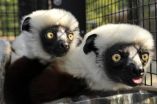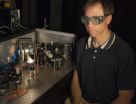(Press-News.org) DURHAM, N.C. -- The young lemur named Eugenius started to get sick. Very sick. He was lethargic, losing weight and suffering from diarrhea. Duke Lemur Center veterinarians soon pinpointed the cause of his illness: Eugenius tested positive for Cryptosporidium, a microscopic intestinal parasite known to affect people, pets, livestock and wildlife worldwide.
In humans, thousands of cases of Cryptosporidium are reported in the United States each year, spread primarily through contaminated water.
Since Eugenius was the first animal diagnosed in 1999, the parasite has caused periodic diarrhea outbreaks at the Duke Lemur Center. All of the infected animals are sifakas -- the only lemur species out of 17 at the center known to fall prey to the parasite -- and most of them were under age five when they got sick.
Despite various efforts to stop the infection, such as quarantining infected lemurs and decontaminating their enclosures, more than half of the sifakas living at the center have tested positive for crypto at some point. While most animals recover, the pattern has veterinarians puzzled over why the outbreaks persist.
Now, thanks to advances in next-generation sequencing technology, researchers are getting closer to understanding how these endangered animals fight the infection and detecting the illness early enough to minimize its spread.
In a study published in the May 29, 2014, edition of Molecular Ecology Resources, Duke researchers Peter Larsen, Ryan Campbell and Anne Yoder used high-throughput sequencing on sifaka blood samples to generate sequence data for more than 150,000 different sifaka antibodies -- protective molecules that latch on to bacteria, viruses and other foreign invaders in the body and fight them off before they cause infection.
Traditional sequencing methods can capture only a fraction of the millions of antibodies circulating in the bloodstream at a given time. But faster next-generation sequencing technology lets researchers sequence a much larger portion of the antibody arsenal. The end result is a high-resolution 'snapshot' of antibody diversity that could shed light on how the immune system responds to stress and infection.
The research is part of a growing field called ecoimmunology, which aims to push the study of immunology beyond lab animals like fruit flies and mice and understand how immune systems function in real-world settings outside the lab.
The next step will be to compare blood samples from healthy and sick lemurs, to see if researchers can identify the specific antibodies that play a role in binding to Cryptosporidium and neutralizing the infection -- information that could be key to developing vaccines.
This research will likely lead to new methods of disease detection and treatment for lemurs in captivity, especially infected animals that show no outward signs of being sick. But it also may lead to monitoring the health status of lemurs and other primates living in the wild simply by screening blood samples for antibody patterns indicating exposure to specific parasites.
That's good news for lemurs in their native home of Madagascar, where lemurs live on the brink of extinction, and where human population growth makes contact with people and inter-species exchange of infectious disease increasingly likely.
INFORMATION:
CITATION: "Next-generation approaches to advancing eco-immunogenomic research in critically endangered primates," Larsen, P., et al. Molecular Ecology Resources, 2014. http://onlinelibrary.wiley.com/doi/10.1111/1755-0998.12274/abstract
Genome sequences show how lemurs fight infection
New technique could aid conservation, disease surveillance
2014-05-30
ELSE PRESS RELEASES FROM THIS DATE:
New printable robots could self-assemble when heated
2014-05-30
Printable robots — those that can be assembled from parts produced by 3-D printers — have long been a topic of research in the lab of Daniela Rus, the Andrew and Erna Viterbi Professor of Electrical Engineering and Computer Science at MIT.
At this year's IEEE International Conference on Robotics and Automation, Rus' group and its collaborators introduce a new wrinkle on the idea: bakable robots.
In two new papers, the researchers demonstrate the promise of printable robotic components that, when heated, automatically fold into prescribed three-dimensional configurations. ...
Radiation for prostate cancer linked to secondary cancers, study finds
2014-05-30
ANN ARBOR, Mich. — Among men treated for prostate cancer, those who received radiation therapy were more likely to develop bladder or rectal cancer, according to a new study from the University of Michigan Comprehensive Cancer Center.
"Overall the incidence of these cancers is low. But when men have received radiation treatments, it's important to evaluate carefully any symptoms that could be a sign of bladder or rectal cancer," says senior study author Kathleen A. Cooney, M.D., professor of hematology/oncology and urology at the U-M Medical School.
The study, which ...
Novel NIST laser system mimics sunlight to test solar cell efficiency
2014-05-30
Researchers at the National Institute of Standards and Technology (NIST) have developed a laser-based instrument that generates artificial sunlight to help test solar cell properties and find ways to boost their efficiency.
The novel NIST system simulates sunlight well across a broad spectrum of visible to infrared light. More flexible than conventional solar simulators such as xenon arc-lamps or light-emitting diodes, the laser instrument can be focused down to a small beam spot—with resolution approaching the theoretical limit—and shaped to match any desired spectral ...
Rush a light wave and you'll break its data, say NIST scientists
2014-05-30
Quantum information can't break the cosmic speed limit, according to researchers* from the National Institute of Standards and Technology (NIST) and the University of Maryland's Joint Quantum Institute. The scientists have shown how attempts to "push" part of a light beam past the speed of light results in the loss of the quantum data the light carries. The results could clarify how noise might limit the transfer of information in quantum computers.
The speed of light in vacuum is often thought to be the ultimate speed limit, something Einstein showed to be an unbreakable ...
Study suggests strong link between depression and early death among seniors with diabetes
2014-05-30
People with diabetes have about double the risk of premature death as people of the same age without diabetes. Studies also have shown that they have about twice the odds of suffering from depression, which further increases their mortality risk.
A new UCLA-led study published in the Journal of the American Geriatrics Society found that among adults 65 and older with diabetes, depression is linked with a far greater chance for early death compared with people of the same age who do not have depression.
The researchers suggest that the higher mortality rate among those ...
Hero or sissy? Study explores perception of injured athletes
2014-05-30
NFL teams shoulder most of the blame for players' injuries and sports journalists can shift football cultural norms toward valuing players who put their health first.
These are the key findings of a new study authored by Clemson University researchers Jimmy Sanderson and Melinda Weathers that examined health and safety issues in sports. It was published in the journal Communication & Sport.
"Media coverage of players who decide to sit out or play through an injury may impact players' future decision-making as well as fans' attitudes towards these players," said Sanderson.
"Sitting ...
Australia's deadly eruptions the reason for the first mass extinction
2014-05-30
A Curtin University researcher has shown that ancient volcanic eruptions in Australia 510 million years ago significantly affected the climate, causing the first known mass extinction in the history of complex life.
Published in prestigious journal Geology, Curtin's Associate Professor Fred Jourdan, along with colleagues from several Australian and international institutions, used radioactive dating techniques to precisely measure the age of the eruptions of the Kalkarindji volcanic province.
Dr Jourdan and his team were able to prove the volcanic province occurred ...
X-ray pulses on demand from electron storage rings
2014-05-30
Everything we know nowadays about novel materials and the underlying processes in them we also know thanks to studies at contemporary synchrotron facilities like BESSY II. Here, relativistic electrons in a storage ring are employed to generate very brilliant and partly coherent light pulses from the THz to the X-ray regime in undulators and other devices. However, most of the techniques used at synchrotrons are very "photon hungry" and demand brighter and brighter light pulses to conduct innovative experiments. The general greed for stronger light pulses does, however, ...
Glow-in-the-dark tool lets scientists find diseased bats
2014-05-29
Scientists working to understand the devastating bat disease known as white-nose syndrome (WNS) now have a new, non-lethal tool to identify bats with WNS lesions —ultraviolet, or UV, light.
If long-wave UV light is directed at the wings of bats with white-nose syndrome, it produces a distinctive orange-yellow fluorescence. This orange-yellow glow corresponds directly with microscopic skin lesions that are the current "gold standard" for diagnosing white-nose syndrome in bats.
"When we first saw this fluorescence of a bat wing in a cave, we knew we were on to something," ...
Police reform law underenforced by Department of Justice
2014-05-29
CHAMPAIGN, Ill. — A law designed to combat police misconduct is hamstrung by limited resources, a lack of transparency and "political spillover" at the U.S. Department of Justice, says a recently published empirical study by Stephen Rushin, a law professor at the University of Illinois and expert in criminal law and policing.
In 1994, Congress passed 42 U.S.C. Section 14141 as part of the Violent Crime Control and Law Enforcement Act, granting the U.S. attorney general the power to initiate structural reform litigation against local police departments engaged in a pattern ...
LAST 30 PRESS RELEASES:
When is it time to jump? The boiling frog problem of AI use in physics education
Twitter data reveals partisan divide in understanding why pollen season's getting worse
AI is quick but risky for updating old software
Revolutionizing biosecurity: new multi-omics framework to transform invasive species management
From ancient herb to modern medicine: new review unveils the multi-targeted healing potential of Borago officinalis
Building a global scientific community: Biological Diversity Journal announces dual recruitment of Editorial Board and Youth Editorial Board members
Microbes that break down antibiotics help protect ecosystems under drug pollution
Smart biochar that remembers pollutants offers a new way to clean water and recycle biomass
Rice genes matter more than domestication in shaping plant microbiomes
Ticking time bomb: Some farmers report as many as 70 tick encounters over a 6-month period
Turning garden and crop waste into plastics
Scientists discover ‘platypus galaxies’ in the early universe
Seeing thyroid cancer in a new light: when AI meets label-free imaging in the operating room
Neutrophil-to-lymphocyte ratio may aid risk stratification in depressive disorder
2026 Seismological Society of America Annual Meeting
AI-powered ECG analysis offers promising path for early detection of chronic obstructive pulmonary disease, says Mount Sinai researchers
GIMM uncovers flaws in lab-grown heart cells and paves the way for improved treatments
Cracking the evolutionary code of sleep
Medications could help the aging brain cope with surgery, memory impairment
Back pain linked to worse sleep years later in men over 65, according to study
CDC urges ‘shared decision-making’ on some childhood vaccines; many unclear about what that means
New research finds that an ‘equal treatment’ approach to economic opportunity advertising can backfire
Researchers create shape-shifting, self-navigating microparticles
Science army mobilizes to map US soil microbiome
Researchers develop new tools to turn grain crops into biosensors
Do supervised consumption sites bring increased crime? Study suggests that’s a myth
New mass spec innovation could transform research
Maternal nativity, race, and ethnicity and infant mortality in the US
Migration-related trauma among asylum seekers exposed to the migrant protection protocols
Jupiter’s moon Europa has a seafloor that may be quiet and lifeless
[Press-News.org] Genome sequences show how lemurs fight infectionNew technique could aid conservation, disease surveillance






